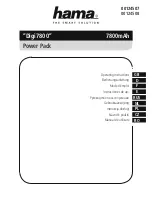
Enatel DC System Manual
Page
7
of
26
Model: RWxxx
Version: 3.6
the rectifier into Float Charge mode after about 4 hours, even if the battery current
remains above the Boost to Float Current threshold.
The Boost and Float voltages are pre-set in the factory but may be adjusted to suit the
specific battery installation.
2.4
Low Voltage Disconnect and Reset (Optional)
The Low Voltage Disconnect (LVD) feature is designed to protect the battery from deep
discharge when the battery is supplying the load current (i.e. mains is off, or the load is
drawing more than the rectifier capacity).
The rectifier monitors the battery voltage when the battery is supplying current, and
disconnects the load from the battery when the battery voltage falls to a pre-set level.
When the battery voltage has increased above the LVD Hysteresis voltage the load is
automatically reconnected back to the battery.
The LVD may be manually reset when it has activated by pressing the LVD Reset button
on the front of the rectifier.
The LVD switches the bve supply (the -ve is common with the battery). Do not
connect the Battery and Load +ve together.
The LVD voltage and the LVD Hysteresis voltage are pre-set in the factory, but may be
adjusted to suit the specific battery installation.
Table 2: Low Voltage Disconnect
Model
Voltage Adjustment Range
Maximum Load Current
RW312U
9.5 to 12V
20A
RW324U
19 to 24V
10A
RW348U
38 to 48V
6A
RW512U
9.5 to 12V
35A
RW517U
9.5 to 12V
26A
RW624U
13 to 17.6V
22A
RW748U
38 to 48V
12A
Do NOT exceed the maximum load current, as the rectifier LVD circuitry may be
damaged. The LVD circuitry is protected by shutting down if its circuitry is overheated due
to over current conditions. Excessive overloading will cause an internal protection fuse to
rupture.
If the LVD functionality is not required, the load must be connected to the Load
connection (not directly onto the battery). That is, connect all Load & battery connections
to load terminal only. Note the Auto Float Boost functionality is lost and the battery
subject to complete drain.
2.5
Temperature Compensation
Batteries require different charging voltages depending on the ambient temperature of
the battery. The colder the battery, the higher the voltage required to charge the battery.








































